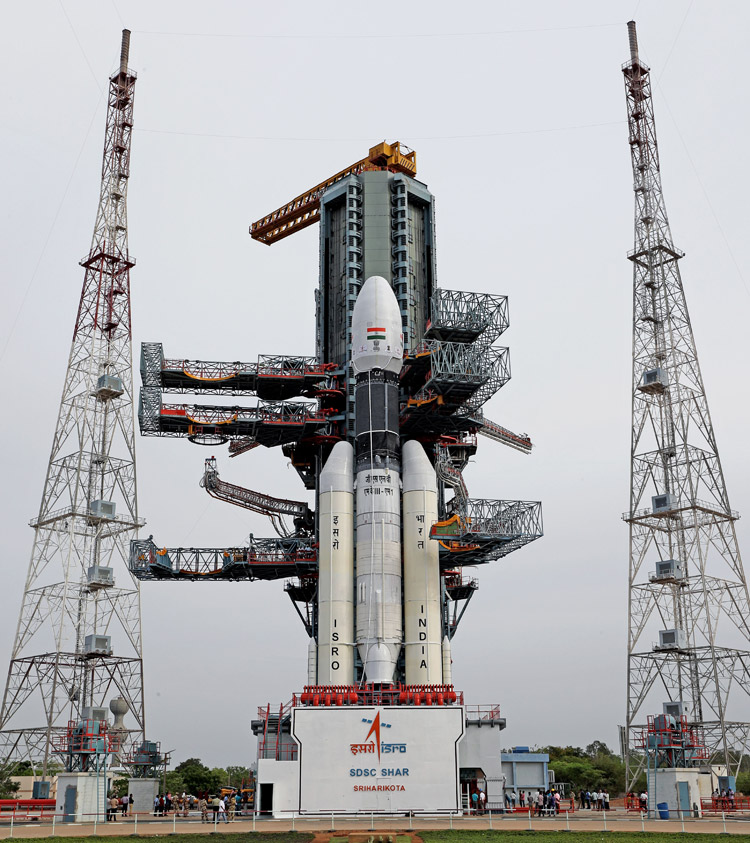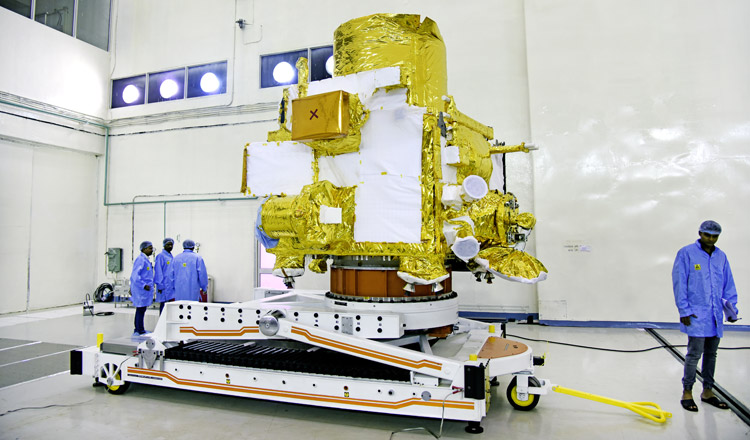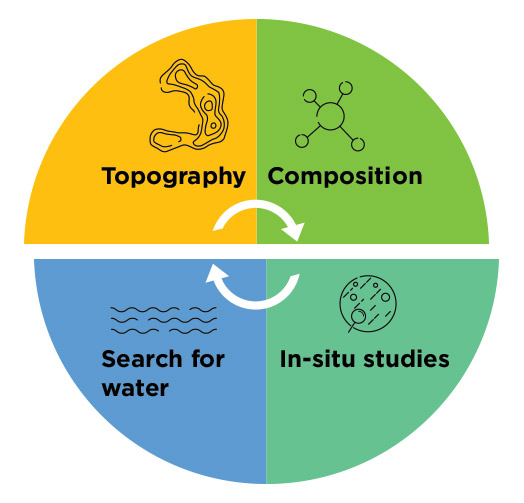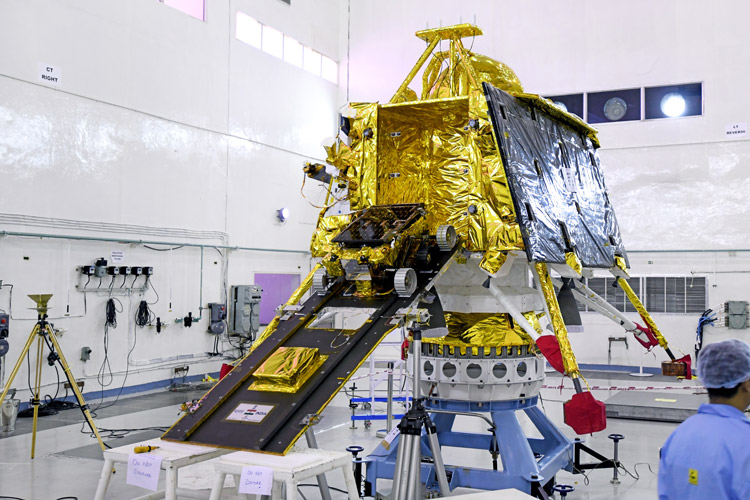INDIAN ARMED FORCES CHIEFS ON
OUR RELENTLESS AND FOCUSED PUBLISHING EFFORTS

SP Guide Publications puts forth a well compiled articulation of issues, pursuits and accomplishments of the Indian Army, over the years

I am confident that SP Guide Publications would continue to inform, inspire and influence.

My compliments to SP Guide Publications for informative and credible reportage on contemporary aerospace issues over the past six decades.
- Prime Minister witnesses 'Bharat Shakti' – a Tri-Services Firing and Manoeuvre Exercise in Pokhran, Rajasthan
- Interim Defence Budget 2024-25 — An Analysis
- Union Defence budget 2024
- Prime Minister Modi Commemorates Indian Navy Day in a Grand Ceremony
- Prime Minister Modi Flies in the LCA Tejas
- New Chapter in India-Italy Defence Ties
- Airpower beyond Boundaries
What makes Chandrayaan-2 India's most complex and ambitious space mission?
India's second lunar mission and the first to soft-land on the lunar surface is sure to establish it globally as a significant space power but only if it does not face any more delays after the seventh one recently.
In the wee hours of July 15, India's second Moon mission, Chandrayaan-2 was called off yet again and not for the first time. This was the seventh time in the series of delay that the launch of this mission has been witnessing since it was originally planned in 2013. The repetitive adjournments in Chandrayaan-2's launch certainly highlight the complexity of this lunar mission. Reaching the Moon is no cakewalk after all. But that does not take away the ambitious nature of this mission.
"ISRO is now embarking on one of the most complex missions since its inception - that of launching Chandrayaan 2", says K Kasturirangan, former Chairman of ISRO. Hear more about what he has to say in this video - https://t.co/JW2qZK9NcZ#Chandrayaan2 #GSLVmkIII #ISRO pic.twitter.com/U9y8rSvY4L
— ISRO (@isro) July 13, 2019
This is India's fourth interplanetary mission at an estimated cost of around 978 crore which is way economical compared to that of China or other countries. Had the launch been successful, India's first soft-landing on Moon mission would have been just a day before Apollo-11 completed its 50 years (July 16, 1969) of having taken the first man to the Moon.
FOURTH COUNTRY IN THE LEAGUE
India's first lunar mission, Chandrayaan-1 had executed the first search for water on the Moon using radars without having landed on the lunar surface. As of now, only Russia, USA, and China have been successful in achieving soft-landing on the Moon. If successful, India would be the fourth country in the list. However, constant hurdles have been coming in the timeline of this mission. Had it been launched last year as it was scheduled earlier, India could have been the third country in the world. It is hoped that the next launch date comes sooner and without any error this time so that Chandrayaan-2 can successfully launch and embark on its mission.
'Chandrayaan-2 is on a mission unlike any before,' states Indian Space Research Organisation (ISRO) highlighting how India's second lunar expedition will shed light on a completely unexplored section of the Moon - its South Polar region. This will indeed be the world's first space mission to conduct a soft landing on the Moon's South Polar Region, according to ISRO.
EXPLORING THE MOON'S SOUTH POLE
'Chandrayaan-2 is on a mission unlike any before,' states Indian Space Research Organisation (ISRO) highlighting how India's second lunar expedition will shed light on a completely unexplored section of the Moon - its South Polar region. This will indeed be the world's first space mission to conduct a soft landing on the Moon's South Polar Region, according to ISRO. The surface area in the South Polar Region of the Moon that remains in shadow is much larger compared to that in the North Polar Region. This makes the Moon's South Pole an area of special interest, hinting at the possibility of the presence of water in permanently shadowed areas around it. ISRO also informs that in addition, South Pole region has craters that are cold traps and contain a fossil record of the early Solar System.

THE EXCLUSIVITY OF THE SPACECRAFT
Also nicknamed as 'Bahubali' rocket, the Geosynchronous Satellite Launch Vehicle-Mark III (GSLV-Mk III) – M1 rocket is being used to carry an orbiter, a lander, and a rover for Chandrayaan-2. Weighing 640 tonnes and standing 44 metres (144feet) high, the three-stage GSLV-Mk III is India's most powerful launcher to date. The GSLV Mk-III will carry Chandrayaan-2 to its designated orbit.
Chandrayaan-2 that weighs 3.8 tonnes comprises of three stages - the 2,379 kg Orbiter, the 1,471 kg Lander named Vikram and the 27 kg Rover named Pragyan.
The Orbiter, with one-year mission life, will examine the surface of the Moon and transfer communication between Earth [by communicating between with the Indian Deep Space Network (IDSN) at Bylalu near Bengaluru] and Vikram.

Named after the father of the Indian Space Programme, Dr. Vikram A Sarabhai, the lander Vikram is designed to function for one lunar day which is equal to 14 Earth days. Devised to perform the nation's first soft landing on the Moon, Vikram is capable of communicating with IDSN as well as the Orbiter and Rover.
Chandrayaan-1 had found evidence of water molecules. ISRO notes that further studies are required on the extent of water molecule distribution on the surface, below the surface and in the tenuous lunar exosphere to address the origin of water on the Moon. Chandrayaan-2 aims to render these.
While Pragyan which in Sanskrit means 'wisdom', is a six-wheeled rover powered with Artificial Intelligence. Clouting solar energy for its functioning, Pragyan can communicate with only the Lander.
The spacecraft also carries several payloads for multiple science experiments. The Orbiter has eight payloads while Vikram has three payloads and Pragyan have two. Some of the key payloads include Chandrayaan 2 Large Area Soft X-ray Spectrometer to study the elemental composition of the Moon, Imaging IR Spectrometer for mineralogy mapping and water-ice confirmation, Synthetic Aperture Radar L & S Band for Polar-region mapping and sub-surface water-ice confirmation, Orbiter High-Resolution Camera for high-resolution topography mapping, etc.
SCIENTIFIC AIMS OF THE MISSION
Chandrayaan-2 is 'Expanding the boundaries of human knowledge', claims ISRO. Through a detailed study of the Moon's topography, seismography, mineral identification and distribution, surface chemical composition, thermo-physical characteristics of topsoil and composition of the tenuous lunar atmosphere with the aid of several payloads, Chandrayaan-2 promises to enhance the lunar scientific knowledge. This is believed to lead to a new understanding of the origin and evolution of the Moon. Remote-sensing observations will be conducted by the payloads on the Orbiter from a 100 km orbit while the Lander and Rover payloads will perform in-situ measurements near the landing site.

To better understand the lunar composition, it is planned to identify the elements and map its distribution on the lunar surface at global as well as in-situ level. Detailed 3-dimensional mapping of the lunar regolith is also envisaged. Measurements on the near-surface plasma environment and electron density in the lunar ionosphere will be studied. Thermo-physical property of the lunar surface and seismic activities will also be measured, as stated by ISRO.
Dr. D.B. Pathak, Principal KV IISC, discusses Chandrayaan 2's voyage to the Moon's south polar region and the uniqueness of this journey. He encourages the youth to dream big and extends his wishes to ISRO for pulling off this remarkable feat - https://t.co/G3ZX3tX7Tw pic.twitter.com/WAi7ym8ksY
— ISRO (@isro) July 11, 2019
LOOKING FOR WATER
Chandrayaan-1 had found evidence of water molecules. ISRO notes that further studies are required on the extent of water molecule distribution on the surface, below the surface and in the tenuous lunar exosphere to address the origin of water on Moon. Chandrayaan-2 aims to render these. As mentioned earlier, the lunar South Pole specifically is interesting because of the possibility of the presence of water in its permanently shadowed areas.
Among the many payloads, the Imaging IR Spectrometer (IIRS) shall be doing complete characterization of water/hydroxyl feature near 3.0 µm for the first time at high spatial and spectral resolutions and the Dual Frequency Synthetic Aperture Radar (DFSAR) will be taking the quantitative estimation of water-ice in the Polar Regions.
Using infra-red spectroscopy, synthetic aperture radiometry & polarimetry as well as mass spectroscopy techniques, ISRO plans to study water molecule distribution.
On this edition of #RocketScience, P Sreekumar — Director of SSPO — helps us understand why we are going back to the Moon, and how Chandrayaan 2 serves to identify the presence of water below the lunar surface - https://t.co/YuN5SkyPZa #Chandrayaan2 #GSLVmkIII #ISRO pic.twitter.com/rhItflbJXU
— ISRO (@isro) July 12, 2019
EARTH-MOON SIMILARITY COULD HELP TRACE EARTH'S EARLY HISTORY
As ISRO states, the Moon is the closest cosmic body at which space discovery can be attempted and documented. It is also a promising test bed to demonstrate the technologies required for deep-space missions. Also noteworthy is that Moon provides the best linkage to Earth's early history. The Moon also offers an undisturbed historical record of the inner Solar system environment. This is likely to not only allow in further understanding the origin of the Moon but also trace the history of Earth.
The Earth and the Moon have a lot more in common than most of us realise. And studying these commonalities will help us understand our own planet better. We hope to do this with #Chandrayaan2! #ISRO #GSLVMkIII pic.twitter.com/vhXjultFbl
— ISRO (@isro) July 13, 2019
MADE IN INDIA
With Chandrayaan-2, some of India's most advanced engineering marvels shall also be displayed. Chandrayaan-2 is the first Indian expedition to attempt a soft landing on the lunar surface and explore the lunar terrain with home-grown technology. The launch vehicle, the GSLV-Mk-III has also been designed and fabricated entirely from within the country. Apart from this, the wholly indigenous rover along with other technology and software in the integrated module have been developed across the country itself. Hence Chandrayaan-2 not only uplifts the nation's advancement in the space sector but also in scientific technologies and innovations as well.

WOMEN HEADING THE MISSION
Edging on almost a decade's scientific research and engineering development, Chandrayaan- 2 is India's first space mission being led by two women scientists of ISRO. Vanitha Muthayya is the project director, and Ritu Karidhal is the mission director. While Vanitha shall be looking into interpreting data from different payloads of spacecraft, Ritu will look after the lunar orbital insertion to the craft.





